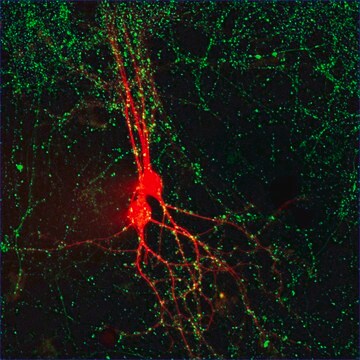SCP0036
Amyloid β 13-16 human
≥95% (HPLC)
Synonym(s):
HHQK
Sign Into View Organizational & Contract Pricing
All Photos(1)
About This Item
Empirical Formula (Hill Notation):
C23H36N10O6
Molecular Weight:
548.60
UNSPSC Code:
12352200
NACRES:
NA.32
Recommended Products
assay
≥95% (HPLC)
form
lyophilized
composition
Peptide Content, ≥45%
storage condition
protect from light
storage temp.
−20°C
Amino Acid Sequence
His-His-Gln-Lys
Application
Amyloid β (Aβ) refers to peptides derived from Amyloid precursor protein that vary in length from 36-43 amino acids. Aβ(s) peptides, their peptide fragments and mutated fragments are used to study a wide range of metabolic and regulatory functions including activation of kinases, regulation of cholesterol transport, function as a transcription factor, and regulators of inflammation. Aβ(s) peptides and their peptide fragments are also used to study oxidative stress, metal binding and mechanisms of protein cross-linking in the context of diseases such as Alzheimer′s disease and neurodegeneration. HHQK is a studied as a unique target site for inhibition of amyloid fibril formation and proteoglycan binding.
Storage Class
11 - Combustible Solids
flash_point_f
Not applicable
flash_point_c
Not applicable
Certificates of Analysis (COA)
Search for Certificates of Analysis (COA) by entering the products Lot/Batch Number. Lot and Batch Numbers can be found on a product’s label following the words ‘Lot’ or ‘Batch’.
Already Own This Product?
Find documentation for the products that you have recently purchased in the Document Library.
Toshio Ariga et al.
Journal of neuroscience research, 88(11), 2303-2315 (2010-07-14)
The extracellular accumulation of amyloid beta proteins (Abetas) in neuritic plaques is one of the hallmarks of Alzheimer's disease (AD). The binding of Abetas to extracellular membranes (ECMs) is a critical step in developing AD. Abetas bind to many biomolecules
J McLaurin et al.
European journal of biochemistry, 267(21), 6353-6361 (2000-10-13)
One of the major clinical features of Alzheimer's disease is the presence of extracellular amyloid plaques that are associated with glycosaminoglycan-containing proteoglycans. It has been proposed that proteoglycans and glycosaminoglycans facilitate amyloid fibril formation and/or stabilize these aggregates. Characterization of
D Giulian et al.
The Journal of biological chemistry, 273(45), 29719-29726 (1998-10-29)
The beta-amyloid peptide 1-42 (Abeta1-42), a major component of neuritic and core plaques found in Alzheimer's disease, activates microglia to kill neurons. Selective modifications of amino acids near the N terminus of Abeta showed that residues 13-16, the HHQK domain
Our team of scientists has experience in all areas of research including Life Science, Material Science, Chemical Synthesis, Chromatography, Analytical and many others.
Contact Technical Service


![[Ala28]-Amyloid β 25-35 ≥95% (HPLC)](/deepweb/assets/sigmaaldrich/product/images/306/938/dd9f7c72-cfca-4ea3-8e10-a7a2a7994639/640/dd9f7c72-cfca-4ea3-8e10-a7a2a7994639.jpg)




